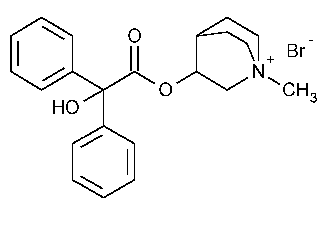Clidinium Bromide
»Clidinium Bromide contains not less than 99.0percent and not more than 100.5percent of C22H26BrNO3,calculated on the dried basis.
Packaging and storage—
Preserve in tight,light-resistant containers.
USP Reference standards á11ñ—
USP Clidinium Bromide RS.USP Clidinium Bromide Related Compound A RS.USP3-Quinuclidinyl Benzilate RS.
Identification—
A:
Infrared Absorption á197Kñ.
B:
Dissolve about 250mg in 5mLof water in a test tube,cool in an ice bath,add 5mLof trinitrophenol TS,and scratch the inner surface of the tube with a glass rod to induce crystallization.Collect the precipitate on a filter,wash with cold water,and dry at 105 for 1hour:the picrate so obtained melts between 184
for 1hour:the picrate so obtained melts between 184 and 189
and 189 ,when tested by the method for Class I(see Melting Range or Temperature á741ñ).[Caution—Picrates may explode.
]
,when tested by the method for Class I(see Melting Range or Temperature á741ñ).[Caution—Picrates may explode.
]
C:
To a solution of 100mg in 2mLof water add a few drops of 2Nnitric acid and 1mLof silver nitrate TS:a yellowish white precipitate is formed.
Loss on drying á731ñ—
Dry it at 105 for 3hours:it loses not more than 0.5%of its weight.
for 3hours:it loses not more than 0.5%of its weight.
Residue on ignition á281ñ:
not more than 0.1%.
Heavy metals á231ñ—
Dissolve 1.0g in 25mLof water:the limit is 0.002%.
Related compounds—
Adsorbent:
0.25-mm layer of chromatographic silica gel mixture.
Developing solvent system:
a mixture of acetone,methanol,water,and hydrochloric acid (70:20:5:5).
Chromatographic plates—
Predevelop suitable thin-layer chromatographic plates (see Thin-Layer Chromatographyunder Chromatography á621ñ)by placing in a chromatographic chamber saturated with Developing solvent system,and allow the Developing solvent systemto move about 15cm.Remove the plates from the chamber,dry at 105 for 15minutes,and cool.
for 15minutes,and cool.
Test solution—
Dissolve 100mg of Clidinium Bromide in 1.0mLof 0.1Nmethanolic hydrochloric acid.
Reference solution 1—
Dissolve 3.0mg of USP3-Quinuclidinyl Benzilate RSin 100mLof 0.1Nmethanolic hydrochloric acid,and mix.
Reference solution 2—
Dissolve 100mg of USP Clidinium Bromide RSin 1.0mLof 0.1Nmethanolic hydrochloric acid,and add 20µLof a solution of 25.0mg of USP Clidinium Bromide Related Compound A RSin 1.0mLof 0.1Nmethanolic hydrochloric acid.
Standard solution—
Dissolve 100mg of USP Clidinium Bromide RSin 1.0mLof 0.1Nmethanolic hydrochloric acid.
Application volume:
20µL.
Spray reagent—
Dissolve 850mg of bismuth subnitrate in a mixture of 10mLof glacial acetic acid and 40mLof water.In a separate container,dissolve 20g of potassium iodide in 50mLof water.Mix the two solutions,and dilute with dilute sulfuric acid (1in 10)to 500mL.Add 7.5±2.5g of iodine,and mix until solution is complete.
Procedure 1(3-quinuclidinyl benzilate)—
Apply the Standard solution,Reference solution 1,and the Test solution,as directed in the chapter.Place the plate in an unsaturated chromatographic chamber containing freshly prepared Developing solvent system,and allow the solvent front to move 10cm.Remove the plate,dry at 105 for 10minutes,cool,and spray with potassium iodoplatinate TS:the RFvalue of the principal spot obtained from the Test solutioncorresponds to that obtained from the Standard solution,and the Test solutionshows no spot at an RFvalue (about 0.8)corresponding to that of 3-quinuclidinyl benzilate.
for 10minutes,cool,and spray with potassium iodoplatinate TS:the RFvalue of the principal spot obtained from the Test solutioncorresponds to that obtained from the Standard solution,and the Test solutionshows no spot at an RFvalue (about 0.8)corresponding to that of 3-quinuclidinyl benzilate.
Procedure 2(limit of clidinium bromide related compound A)—
Apply Reference solution 2and the Test solutionto a second Chromatographic plateas directed in the chapter.Place the plate in an unsaturated chromatographic chamber containing freshly prepared Developing solvent system,and allow the solvent front to move 15cm.Remove the plate,dry at 105 for 10minutes,cool,and spray with Spray reagent.Any spot in the chromatogram obtained from the Test solutionat an RFvalue of about 0.4is not greater in size or intensity than the minor spot obtained from Reference solution 2:not more than 0.5%of clidinium bromide related compound Ais found.
for 10minutes,cool,and spray with Spray reagent.Any spot in the chromatogram obtained from the Test solutionat an RFvalue of about 0.4is not greater in size or intensity than the minor spot obtained from Reference solution 2:not more than 0.5%of clidinium bromide related compound Ais found.
Organic volatile impurities,Method Iá467ñ:
meets the requirements.
Assay—
Dissolve about 1.2g of Clidinium Bromide,accurately weighed,in 80mLof glacial acetic acid,warming if necessary to effect solution.Cool,add 15mLof mercuric acetate TS,and titrate with 0.1Nperchloric acid in dioxane VS,determining the endpoint potentiometrically.Perform a blank determination,and make any necessary correction.Each mLof 0.1Nperchloric acid is equivalent to 43.24mg of C22H26BrNO3.
Auxiliary Information—
Staff Liaison:Elena Gonikberg,Ph.D.,Scientist
Expert Committee:(PA4)Pharmaceutical Analysis 4
USP28–NF23Page 492
Pharmacopeial Forum:Volume No.27(4)Page 2720
Phone Number:1-301-816-8251
